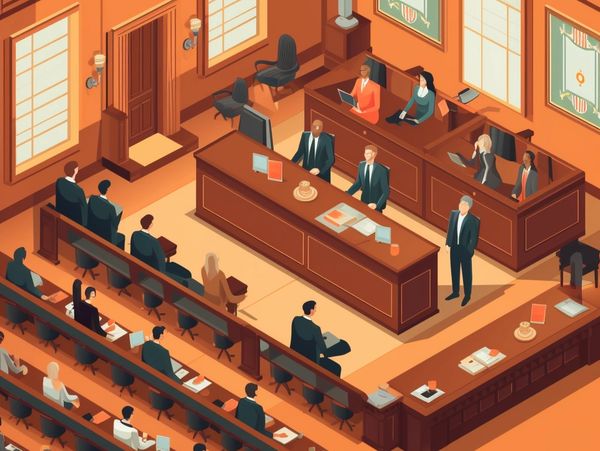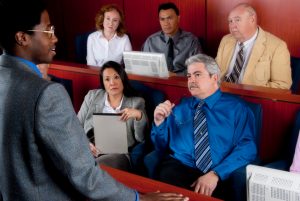Navigating the Complexities of Trial Presentations: Tips for Seamless Distribution and Compelling Arguments
In the world of legal procedures, the art of trial presentation stands as a vital determinant of success. The intricacies fundamental in trial discussions require a delicate equilibrium of method, finesse, and skill.

Comprehending Trial Goals
To properly browse a trial, it is vital to have a clear understanding of the purposes that need to be achieved. Prior to entering the court room, lawful groups should define their objectives and desired end results. These purposes function as leading principles throughout the trial, shaping approaches and affecting decision-making procedures.
Comprehending trial objectives includes an extensive evaluation of the situation, legal criteria, and the customer's benefits. Trial Presentations. It requires a meticulous evaluation of the facts, recognizing vital problems, and preparing for possible challenges. By setting particular and quantifiable objectives, lawyers can tailor their disagreements and discussions to line up with the preferred outcomes
Moreover, a clear understanding of trial purposes enables legal groups to focus on evidence, witnesses, and lawful disagreements successfully. It permits the advancement of a meaningful story that resonates with the discretionary, reinforcing the general situation discussion.

Organizing Proof Effectively
Having a clear understanding of test objectives lays the structure for organizing proof efficiently in legal procedures - Trial Presentations. By aligning the discussion of evidence with the preferred outcomes of the test, lawful groups can enhance their disagreements and enhance their persuasiveness. One vital aspect of organizing evidence is classification. Grouping proof based on styles or significance to certain lawful aspects can help enhance the presentation and make complex information a lot more digestible for the court or court.
One more key component in arranging evidence successfully is establishing a sensible circulation. Providing evidence in a coherent and consecutive fashion can help construct a compelling story that supports the legal arguments being made. Furthermore, utilizing visual aids such as timelines, graphes, or charts can even more enhance the organization of proof and aid in clearing up complex relationships or series of occasions.
Furthermore, making sure that all evidence provided is permissible and relevant to the instance is vital. Irrelevant or inadmissible proof can detract from the strength of the argument and possibly hurt the reliability of the providing celebration. A careful evaluation and option procedure should be embarked on to include only the most legitimately sound and impactful proof in the test presentation.
Crafting Convincing Narratives
Crafting compelling stories plays a critical function in offering convincing arguments throughout legal process. browse around these guys When constructing a narrative for a trial presentation, it is essential to establish a clear story that highlights crucial points and links them in a systematic manner. By weaving with each other evidence, testimony, and legal debates into a influential and cohesive story, lawful professionals can efficiently support for their clients and raise the probability of a desirable result in the court.
Understanding Visual Help
Efficient use visual aids is essential to improving the effect and clearness of test discussions. Aesthetic help, when used tactically, have the power to streamline complex information, enhance vital points, and leave an enduring impact on the court and jury. To understand visual aids in test discussions, it is important to make sure that they are clear, succinct, and appropriate to the debates being made.
When incorporating visual help, such as charts, timelines, charts, or photos, right into a trial discussion, it is crucial to keep them aesthetically appealing yet professional. The visuals must match the verbal disagreements, providing a graph of the info being talked about without overwhelming the target market with unneeded details.
Moreover, experimenting the aesthetic help in advance is crucial to make certain a seamless distribution during the trial. Familiarizing oneself with the material, changes, and timings of each visual help can assist maintain the flow of the presentation and prevent technological glitches that might occur.
Providing Impactful Closing Disagreements
An engaging closing debate functions as the conclusion of a trial presentation, encapsulating the core story and persuading the judge and jury towards a favorable choice. To deliver an impactful closing argument, it is important to succinctly evaluate bottom lines, highlight the staminas of your situation, and attend to any type of weaknesses in a tactical way. Begin by laying out the primary arguments that sustain your customer's setting, emphasizing why the evidence offered throughout the test sustains your story. It is necessary to create a sense of cohesion and clarity, leading the discretionary towards the desired final thought.
Additionally, incorporating sob story can additionally enhance your closing debate. By humanizing the instance and attaching on an individual degree with the decision-makers, you can stimulate compassion and understanding, influencing their assumption of the facts offered. In addition, restating the legal criteria that must be met for a favorable ruling can reinforce the validity of your placement. Ultimately, a well-crafted closing argument should leave a long-term impression, compelling the discretionary to rule in your client's favor.
Conclusion
In final thought, grasping trial discussions includes comprehending goals, organizing proof, crafting narratives, utilizing visual help, and providing impactful closing debates. By applying these techniques properly, attorneys can present their situation flawlessly and make engaging debates in the courtroom. It is important to navigate the intricacies of trial discussions with precision and ability to accomplish success in legal procedures.
By aligning the discussion of evidence with the wanted end results of the test, more information lawful groups can strengthen their disagreements and improve their persuasiveness (Trial Presentations). To understand aesthetic help in trial presentations, it is vital to make certain that they are clear, concise, and appropriate to the debates Continued being made
A compelling closing debate offers as the conclusion of a test discussion, enveloping the core story and encouraging the court and jury towards a positive decision. Begin by detailing the main arguments that support your customer's placement, highlighting why the evidence provided throughout the test supports your story.In verdict, grasping test presentations includes recognizing objectives, arranging evidence, crafting stories, utilizing visual help, and supplying impactful closing debates.